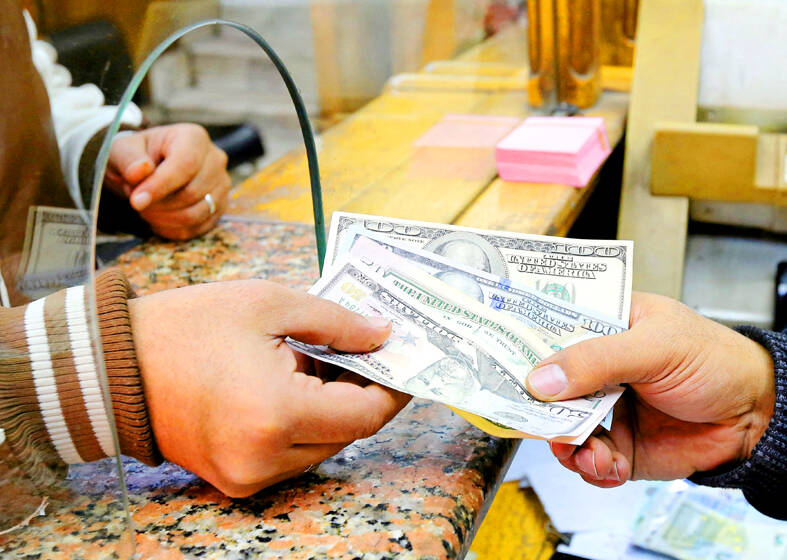The US dollar fell on Friday, but was still on track for its biggest annual gain since 2015, in the last trading day of a year dominated by US Federal Reserve rate hikes and fears of a sharp slowdown in global growth.
Asian equities had risen earlier in the session after market sentiment on Wall Street on Thursday got a boost from data showing rising US jobless claims, which suggested the Fed’s interest rate hikes were lowering demand for labor.
With liquidity lower due to holidays, the US dollar index was down about 0.3 percent on the day at 103.720.

Photo: REUTERS
The Fed has raised rates by a total of 425 basis points since March last year in an attempt to curb surging inflation.
Against a basket of currencies, the US dollar gained 8.4 percent on average last year, its biggest annual jump in seven years, but it has pared some gains in the past few weeks as investors expected the Fed’s rate-hiking cycle to end this year.
“We’re not yet convinced that the Fed is turning dovish or that the US inflation will come to target for good, so there’s room for the dollar to rebound,” Nordea chief analyst Jan Von Gerich said. “But for the near-term outlook we’re looking for some more performance in the euro versus the dollar.”
On Friday, the euro was up 0.2 percent at US$1.0681, on track for a 6.2 percent annual loss versus the US dollar, compared with last year’s 7 percent drop. A combination of weak eurozone growth, the war in Ukraine and the Fed’s hawkishness put the euro under pressure last year.
European Central Bank executive board member Isabel Schnabel last week said that the central bank must be prepared to raise interest rates further, including by more than what the market expects, if that is needed to bring down inflation.
The New Taiwan dollar rose against the US dollar on Friday, gaining NT$0.024 to close at NT$30.708, up 0.013 percent from NT$30.712 a week earlier.
The British pound on Friday was down 0.1 percent, set for a 11 percent annual drop.
The Australian dollar, seen as a liquid proxy for risk appetite, on Friday was up 0.3 percent at US$0.6796, but on track for a 6.5 percent drop for the whole of last year.
China’s offshore yuan was up about 0.9 percent against the US dollar, with the pair at 6.9085. Still, it was set for an 8.6 percent annual drop, hurt by US dollar strength and a domestic economic slowdown.
Optimism about China’s reopening after three years of strict COVID-19 curbs has been tempered by surging infections which threaten more economic disruptions.
Taiwan, India, Italy, Japan, South Korea and the US are among the countries that have imposed COVID-19 test requirements for travelers from China.
The WHO said it needs more information to assess the latest surge in infections in China.
Von Gerich said China’s reopening “will be a source of volatility.”
“But when we get past that, when we really get to the really positive economic impact, I think it should boost risk appetite globally,” he added.
The US dollar was down about 0.9 percent against the yen, at 131.85.
The Bank of Japan’s dovish stance has seen the US dollar gain 14.5 percent versus the yen last year, in the yen’s worst performance since 2013.
However, the Bank of Japan’s surprise decision to tweak its bond yield control program saw the yen jump to a four-month high against the US dollar early last month.
The Swiss franc was steady versus the US dollar, at SF0.92275.
The Swiss National Bank increased the amount of the Swiss currency it sold in the third quarter of last year, the central bank said on Friday, indicating that its focus has switched from stemming the franc’s strength to fighting inflation.
Additional reporting by staff reporter, with CNA

DIVIDED VIEWS: Although the Fed agreed on holding rates steady, some officials see no rate cuts for this year, while 10 policymakers foresee two or more cuts There are a lot of unknowns about the outlook for the economy and interest rates, but US Federal Reserve Chair Jerome Powell signaled at least one thing seems certain: Higher prices are coming. Fed policymakers voted unanimously to hold interest rates steady at a range of 4.25 percent to 4.50 percent for a fourth straight meeting on Wednesday, as they await clarity on whether tariffs would leave a one-time or more lasting mark on inflation. Powell said it is still unclear how much of the bill would fall on the shoulders of consumers, but he expects to learn more about tariffs

Meta Platforms Inc offered US$100 million bonuses to OpenAI employees in an unsuccessful bid to poach the ChatGPT maker’s talent and strengthen its own generative artificial intelligence (AI) teams, OpenAI CEO Sam Altman has said. Facebook’s parent company — a competitor of OpenAI — also offered “giant” annual salaries exceeding US$100 million to OpenAI staffers, Altman said in an interview on the Uncapped with Jack Altman podcast released on Tuesday. “It is crazy,” Sam Altman told his brother Jack in the interview. “I’m really happy that at least so far none of our best people have decided to take them

PLANS: MSI is also planning to upgrade its service center in the Netherlands Micro-Star International Co (MSI, 微星) yesterday said it plans to set up a server assembly line at its Poland service center this year at the earliest. The computer and peripherals manufacturer expects that the new server assembly line would shorten transportation times in shipments to European countries, a company spokesperson told the Taipei Times by telephone. MSI manufactures motherboards, graphics cards, notebook computers, servers, optical storage devices and communication devices. The company operates plants in Taiwan and China, and runs a global network of service centers. The company is also considering upgrading its service center in the Netherlands into a

NOT JUSTIFIED: The bank’s governor said there would only be a rate cut if inflation falls below 1.5% and economic conditions deteriorate, which have not been detected The central bank yesterday kept its key interest rates unchanged for a fifth consecutive quarter, aligning with market expectations, while slightly lowering its inflation outlook amid signs of cooling price pressures. The move came after the US Federal Reserve held rates steady overnight, despite pressure from US President Donald Trump to cut borrowing costs. Central bank board members unanimously voted to maintain the discount rate at 2 percent, the secured loan rate at 2.375 percent and the overnight lending rate at 4.25 percent. “We consider the policy decision appropriate, although it suggests tightening leaning after factoring in slackening inflation and stable GDP growth,”